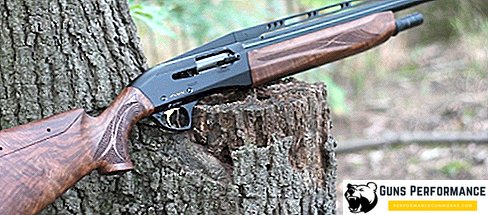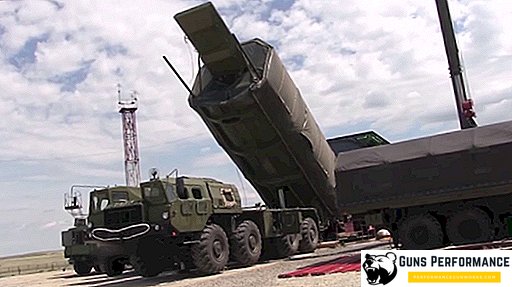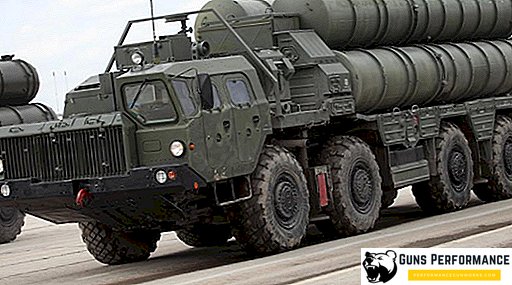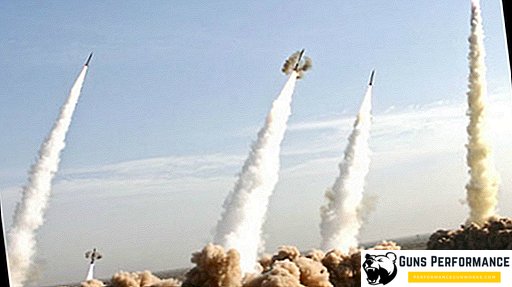
The GP-25 "Koster" is a Soviet single-shot grenade launcher developed at the end of the 70s by gunsmiths of the Tula Design Bureau and specialists of the Moscow State Scientific Production Enterprise Pribor. This weapon is intended to defeat enemy personnel both in the open and in the trenches, in the trenches or behind the folds of the terrain. The under-barrel grenade launcher GP-25 is designed for installation on various types of Kalashnikov assault rifles of 7.62 mm and 5.45 mm caliber. GP-25 "Fire" is a rifled muzzle-charging weapon.
The Afghan war became the baptism of this grenade launcher, during which the GP-25 proved to be a reliable and effective weapon. After that there were numerous conflicts in the post-Soviet space, including two Chechen campaigns. Currently GP-25 sub-barrel grenade launcher is actively used by all parties to the civil conflict in Syria.

GP-25 was put into service in 1978, at the same time began its mass production. This weapon is still in use by the Russian army, in addition, the GP-25 is used by the Ukrainian and Bulgarian armed forces. The release of the grenade launcher continues in our days.
In the late 1980s, a more sophisticated version of the grenade launcher, the GP-30, with a smaller mass and simpler design was developed.
History of creation
Well-known rocket launchers began to be actively used during the Second World War. Very quickly, they proved to be a simple and effective anti-tank weapon. However, it was poorly suited to combat the enemy infantry.
The so-called rifle grenades that appeared on the eve of the First World War can be considered the forerunners of modern grenade launchers. Although, the idea of using an infantryman’s standard firearm for throwing hand grenades is much older: as early as the 18th century, special funnels were invented that were put on the barrel of muskets. With their help, various explosive objects were thrown into the thick of enemy troops. Most often, such weapons were used in the defense of fortresses by their garrisons.

During World War I, a hand grenade became one of the main means of defeating enemy personnel both on the offensive and on the defensive. During positional battles, the trenches of the opposing sides were often at a distance of a hand grenade throw. Therefore, the soldiers began to invent various ways how to throw a grenade further and more accurately. Originally used various slings and catapults. However, very soon they were replaced by rifle grenades.
Another reason for the appearance of this weapon was the "dead" zone between the maximum range of using hand grenades (approximately 50 meters) and the minimum distance of mortar fire (from 150 meters). There was absolutely nothing for the infantry to suppress enemy firing points in this range, except for small arms fire, which could not always cope with the task.
The idea was very simple: a special grenade was inserted into the barrel of the most ordinary serial rifle, and with the help of a single shot was sent towards the enemy. The energy of the shot was quite enough to throw ammunition a few tens of meters. The rifle grenades had several basic types of structures; they were equipped with percussion or remote action fuses. For firing rifle grenades on the barrel of the weapon various nozzles were installed, as well as special aiming devices.
Over the development of rifle grenades, designers from different countries worked actively in the period between the two world wars. This type of weapon was used in the Second World War, but with its end, he began to gradually leave the stage. The main disadvantage of rifle grenades was the inability to use small arms in the normal mode before shooting grenades.

After the war, infantry began to develop light grenade launchers, which very quickly became very serious assault weapons. The pioneers in this area were the Germans, they mastered the production of special grenades for signal pistols. In the 60s, the Americans created a hand-held grenade launcher M79, the design of which resembled an ordinary hunting rifle. His trunk broke, and a grenade was inserted into it. M79 had a wooden butt and special sights. This grenade launcher is still in service with the US Army. Americans are very active in using it in Vietnam.
However, such a weapon, although it possessed considerable firepower, had several serious flaws, the main of which was the need for additional small arms. The M79 weighed 2.7 kg and had fairly solid dimensions, so the fighter was uncomfortable to wear (and even more to use) it together with an automatic rifle or a submachine gun. The solution to this problem was in the air: in the late 60s, the US Army signed a contract to build a rifle grenade launcher for an M-16 rifle. Already in 1970, an experimental batch of grenade launchers went into the Vietnamese jungle.

The Soviet military very quickly learned about the existence of a new American weapon and wanted to get an equivalent for it. It cannot be said that up to this point in the USSR no one was engaged in the development of such grenade launchers (the Iskra project, for example), but they did not evoke much interest. The development of a grenade launcher was entrusted to several design bureau at once, but all the prototypes did not have the required technical and operational characteristics.
Among the developers of new weapons was the Tula Design Bureau, which had a wealth of experience in creating hunting and military weapons. Directly the grenade launcher was entrusted with the design of the gunsmith V.N. Teleshe, he carried out the work together with the specialists of the Moscow State Scientific Production Enterprise "Pribor". The result of this collaboration was the grenade launcher GP-25 "Koster", which was put into service in 1978. However, the mass production of these weapons was deployed only in 1980, after the start of the war in Afghanistan. And in conditions of real hostilities, this grenade launcher showed the highest reliability and efficiency.

The grenade launcher could be mounted on Kalashnikov assault rifles of any caliber. The GP-25 device was extremely simple, with a minimum of moving parts, so there was practically nothing to break in it. The fighter had to simply insert a grenade into the barrel, aim and fire a shot. At the same time, the shooting could be conducted both at direct fire, and along a hinged trajectory, hitting opponents hidden behind natural barriers. This was especially important during mountain fighting.
During the battle, the soldier could almost instantly switch from a machine gun to a grenade launcher. Special training for the use of GP-25 was not required; any fighter could master this weapon as soon as possible. The grenade launcher could be used both as a means of fire support and for various assault operations.
Possessing a relatively small mass (about 1.5 kg) and dimensions (330 mm), the grenade launcher has an excellent target range and excellent firing rate. From GP-25 it is not necessary to extract the used cartridges, to carry out manipulations with the bolt, which significantly increases its practical rate of fire and favorably distinguishes it from foreign analogues. In a minute a fighter can make up to five shots. Dulnocharging and the absence of the liner are the definite advantages of the Soviet grenade launcher.
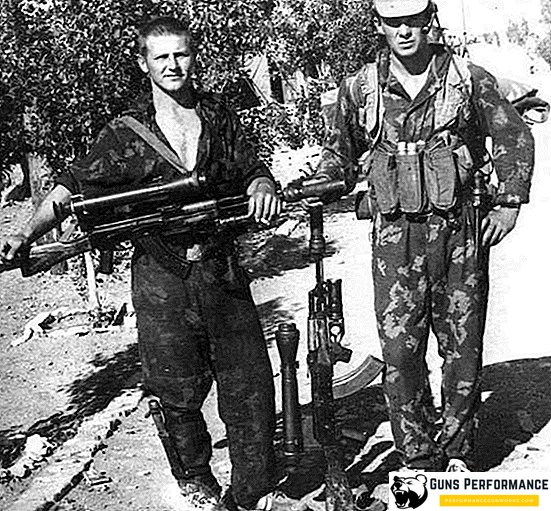
But that's not all. In the memoirs of the Afghan soldiers it is difficult to find at least one mention of the refusal of the "grenade launcher". The standard fighter’s ammunition consisted of ten grenades, placed in two cloth bags, five each. They were located on the sides of the body, which was very convenient and allowed to get grenades in almost any position. It was possible to take additional ammunition, in this case the number of shots for the GP-25 increased to 20. The shots of VOG-25 and VOG-25P made it possible to confidently hit enemy infantry at a distance of 400 meters.

In 1989, based on the GP-25, an improved modification of this weapon was developed — the GP-30 Obuvka. When creating it, the experience of using grenade launchers in the Afghan campaign was fully taken into account. GP-30 received a new sight, which did not require a switch in range, the weight of the grenade launcher decreased by 200 grams, and the rate of fire increased to 10-12 rounds per minute. It should be noted that the appearance of the GP-25 and GP-30 differ very slightly.
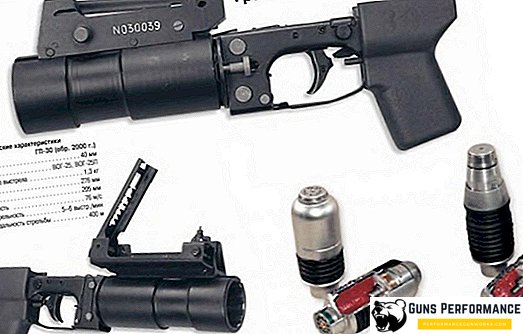
When using a grenade launcher, a fighter should consider some of the nuances. With the "grenade launcher" the machine becomes much heavier. For example, the mass of the AK-74 increases to 5.1 kg. In addition, the center of gravity of the weapon is shifted forward. However, this is only good for the Kalash: the weighted front of the weapon does not allow the machine to “kick the gun” so much after the shot that it increases the accuracy of the shooting. But in any case, shooting with a grenade launcher has its differences and to get used to them you need some practice.
Description of construction
GP-25 is a single-shot rifled grenade launcher charged from the barrel. The weapon consists of three parts: a breech, a barrel with a mount and a sight, as well as a firing mechanism. For carrying a grenade launcher, it is usually disassembled into two parts: the barrel with a sight and mount, as well as a breech with a trigger mechanism. The grenade launcher also includes a special rubber butt plate for the butt and tools for cleaning and maintaining weapons.
The length of the GP-25 barrel is five calibers of a grenade launcher (205 mm), it has 12 right-side rifling, a special spring-loaded clamp holds the grenade in the barrel bore.
The trigger mechanism GP-25 - hammer type, self-cocking. The grenade launcher is moving straight, with the help of a hook it pulls back the trigger and compresses the mainspring. Then the trigger breaks off the hook and the striker sends the hammer forward, which breaks the grenade cap. The GP-25 has a two-position safety lock, as well as a special mechanism that blocks the impact mechanism in case the grenade launcher is incorrectly mounted on the machine gun. The latch in the barrel is also connected to the percussion mechanism and if the grenade is not fully sent, then it is impossible to make a shot - the drummer is blocked.
For convenience, the arrow GP-25 is equipped with a plastic hollow handle.
The aiming devices of the grenade launcher make it possible to fire with direct and half-direct fire. The maximum range of both mounted and flat shooting is 400 meters.
The grenade launcher can be discharged using a special extractor.
The standard shot for GP-25 is VOG-25, which is made according to the caseless design. This means that both the primer and the propellant are inside its hull (at the bottom). Such a scheme has greatly simplified the design of the ammunition, as well as several times to increase the rate of fire of the weapon.
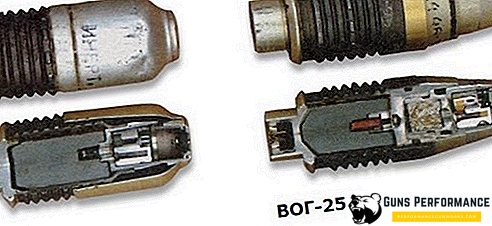
The grenade has a steel case, under which is a cardboard grid that promotes the rational formation of fragments during an explosion.
On the outer surface of the case are ready-made rifling, which give the ammunition rotational motion. It is with his help that the grenade is stabilized in flight.
The grenade is equipped with a head fuse contact action with a long-cocking and self-destruct. On a combat platoon the ammunition becomes at a distance of 10-40 meters from the muzzle. The self-liquidator works 12-14 seconds after the shot.

In addition to the VOG-25 ammunition, the GP-25 can use the VOG-25P “jumping” grenades and the “Nail” grenade with tear gas. VOG-25P has a special charge, which is triggered after a collision of a grenade with an obstacle and throws it at 0.5-1 meter. And only then does the fuse work.
VOG-25 has an effective radius of five meters.
Specifications
| Caliber, mm | 40 |
| Barrel length, mm | 98 |
| Number of rifling | 12 |
| Mass of grenade launcher, kg | 1,5 |
| Length of grenade launcher, mm | 323 |
| Sighting range, m | |
| maximum | 400 |
| minimum when mounted shooting | 200 |
| Practical rate of fire, rds / min | 4-5 |


